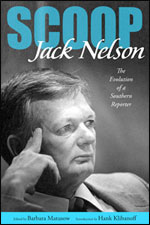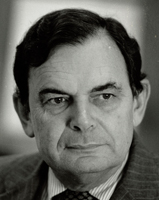
Major dailies eventually did what the black press had been doing for years: cover racial injustice as an ongoing story. Photo © Steve Schapiro/Corbis
A running joke about Louis M. Lyons—the taciturn genius who was the Nieman Foundation’s curator for 25 years—was that when you first got to

Scoop:
The Evolution of a Southern Reporter
By Jack Nelson
Edited by Barbara Matusow
University Press of Mississippi. 188 pages

Beware of Limbo Dancers:
A Correspondent’s Adventures with The New York Times
By Roy Reed
University of Arkansas Press. 261 pagesknow him, he stared at his shoes. Then, when you really got to know him, he stared at your shoes.
There was, however, no better student of the American press than Lyons during his curatorial years, from 1939 to 1964. He had the ability to see developing, under-covered national and international stories early on and then arrange fellowships for journalists likely to cover them. He was far ahead of the vast majority of the nation’s editors and publishers in recognizing the emerging racial story. He and his selection committees reached out in the ’40s, ’50s and ’60s not only to white Southern journalists at mainstream papers but to black journalists whose job opportunities during those years were almost entirely limited to black publications.
It is difficult to imagine how racial coverage might have developed had it not been for the input of Nieman Fellows. My view on this comes in part from being one of the Southerners brought to Harvard, but mostly from my interviews and research for "The Race Beat: The Press, the Civil Rights Struggle, and the Awakening of a Nation," the 2006 book I co-authored with Hank Klibanoff.
When the Little Rock desegregation crisis erupted in 1957, a former Nieman Fellow, Harry Ashmore, class of 1942, was in the editor’s chair at the Arkansas Gazette and put most of his staff on the story, setting a high standard for the coverage of racial crises yet to come. He also wrote editorials saying that if the federal government could not enforce the Supreme Court’s school desegregation decision, it was inviting anarchy in the South. Ashmore’s stand made it easier for President Dwight D. Eisenhower to intervene by sending in federal troops.
When violence flared in Alabama in 1961 against freedom riders attempting to desegregate interstate buses, only two reporters were on the buses. Both were black; one, Simeon Booker, was a Nieman, class of 1951, and full time on the race beat for Jet and Ebony magazines.
When Martin Luther King, Jr. launched his campaign for voting rights in Selma, Alabama in 1965, only three reporters were covering the South on an ongoing basis for non-Southern newspapers. All three were Nieman Fellows during the Lyons era—John Herbers and Roy Reed of The New York Times and Jack Nelson of the Los Angeles Times.
In a fortuitous coincidence, Booker, Nelson and Reed have books that are being published, Nelson’s posthumously, within a few months of each other. These books add impressively to our knowledge of the crucial civil rights years of the 1950s and ’60s and give gripping insight into the journalists who covered the story. They also underscore the importance of Nieman fellowships in shaping careers and invigorating news coverage.
I confess, in the interest of full disclosure, and indeed am proud, that Reed and I worked together as Southern correspondents for The New York Times in the ’60s and began a friendship that has endured for decades. I was in the same Nieman class as Nelson, became a close friend, and can testify that the title of his book, "Scoop," is an accurate reflection of his prowess. As for Booker, we were never, alas, in the same place at the same time in the civil rights years, but I have admired his work from afar for decades.
At the end of his year at Harvard, Booker became the first black journalist hired onto the staff of The Washington Post. He was not well received, either by his Post colleagues or on the beats that he covered in a capital that was then racially segregated. He left the Post to cover racial issues for Jet and Ebony, magazines that until then had focused more on black celebrities than on civil rights. He covered the assassinations of black leaders trying to register black voters in the Mississippi Delta, the Emmett Till murder trial, and a long string of civil rights battles.
The Post might have been wise to have assigned Booker to the race beat, but no mainstream newspaper in America saw race as an ongoing story until the Till trial in 1955, more than a year after the Supreme Court’s school desegregation decision. Racial coverage was left to the black press.
"I did my best to tough it out at the Post," Booker writes in "Shocking the Conscience: A Reporter’s Account of the Civil Rights Movement," the book he co-authored with his wife, Carol McCabe Booker, "although it was quite a comedown from the equality and cordial collegiality I had experienced in Cambridge as a Nieman Fellow, and I got to know only a few of the paper’s reporters."
Nelson might never have covered the racial story if not for his Nieman Fellowship. He had already won a Pulitzer Prize for his exposé of corruption and abominable patient treatment at Georgia’s hospital in Milledgeville for the mentally ill, and a long, fruitful career as one of the nation’s top investigative journalists seemed assured.
At Harvard, Nelson’s interest in racial coverage was piqued by courses taught by Thomas Pettigrew, a social psychologist who studied racial prejudice, and American history professor Frank Freidel.
When the Los Angeles Times offered Nelson a job as its chief Southern correspondent, he vacillated a bit but said yes. Nelson had a keen sense of outrage when confronted with injustice, a trait that made him a superior investigative reporter. It also served him well on the racial beat. When he saw sheriff’s deputies beating children for doing nothing more than peacefully protesting racial discrimination, his sense of fairness erupted and his reporting was vivid.
Nelson’s autobiography "Scoop: The Evolution of a Southern Reporter"—edited by his widow, Barbara Matusow—is a Horatio Alger tale, the rise of a street corner newsboy to the peak of journalism as Washington bureau chief of the Los Angeles Times, in that paper’s heyday, by way of the race beat. It should be required reading for any aspiring journalist.
Reed didn’t need a Nieman to arouse his interest in the racial story. He had been in the thick of it on staff at the Arkansas Gazette covering the long-running saga of a defiant segregationist governor, Orval Faubus, who lashed out against efforts to desegregate Little Rock’s Central High School. The Nieman gave him distance from the South at a critical juncture in his career and whetted what was a natural disposition toward philosophy and history.
Reed’s stories on race in the South for The New York Times, after his Nieman, were not only some of the best written of the era, they were chock-full of telling details.
Reed saw, for example, during racial turmoil in Bogalusa, Louisiana in 1965 that if a town’s leaders did not react quickly to white violence and race-baiting, they ceded power to the mob and could not easily regain it. One town elder appeared before an angry, "nigger"-shouting crowd at the height of tension there and asked for just two minutes to appeal for calm. "They turned him down," Reed reported, "and he hung his head and went home."
Reed, whose book "Beware of Limbo Dancers: A Correspondent’s Adventures with The New York Times," oozes wit and charm, casts a wary eye toward fellow charmers when they happen to be politicians—the wily Governor Faubus, for example.
Booker, Nelson and Reed have markedly different writing styles, but each in his own way wrote stunning accounts of memorable events when they were reporting the struggle for racial equality. These books, written late in their lives, gave them each an opportunity to reflect on their stories, their careers, and a stormy but crucial American era.
Their memoirs are important events, not just for journalism, but for American history.
Louis Lyons was at the top of his game when he brought these three journalists to Harvard.
Gene Roberts, a 1962 Nieman Fellow, is co-author of "The Race Beat: The Press, the Civil Rights Struggle, and the Awakening of a Nation."




